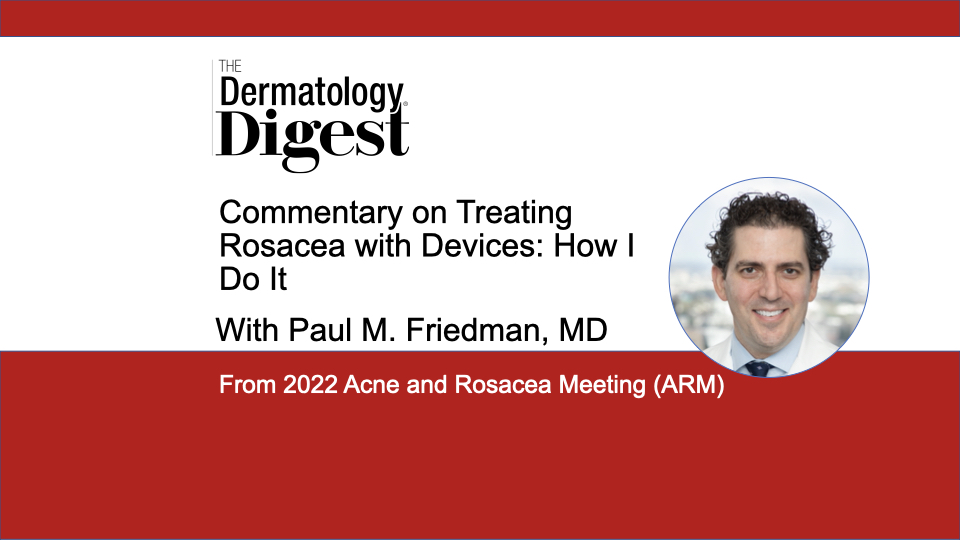Dr. Paul Friedman discusses yellow and green light devices for treating erythematotelangiectatic rosacea.
Paul M. Friedman, MD, is Director, Dermatology & Laser Surgery Center, Houston, Texas
“In terms of our practice, what we’re most commonly utilizing for the treatment of rosacea is the pulsed dye laser… it’s yellow light, and it’s been shown to safely and effectively reduce both facial erythema and telangiectasias and has been the standard of care for years,” said Paul M. Friedman, MD, who presented “Treating Rosacea with Devices: How I Do It” at the 2022 Acne and Rosacea Meeting, held in partnership with the Cosmetic Bootcamp meeting in Aspen, Colorado.
The pulsed dye laser has large and varied spot sizes for effectively targeting erythematotelangiectatic rosacea across the face by specifically targeting oxyhemoglobin in the vessels, he said.
“And if patients are willing to undergo the downtime, it’s not uncommon for us to do two passes or even sometimes, if we’re focusing on individual telangiectasia, changing up spot sizes and doing an additional pass on that area as well.”
Patients with moderate to severe erythematotelangiectatic rosacea will typically receive a first pass using a longer pulse duration, for example 6 milliseconds, said Dr. Friedman.
“Then I’ll go over to the other side of the face and treat the other side of the face while I’m cooling [the treated] side of the face. And we’ll come back and do a subsequent pass at a 3-millisecond range.”
By adjusting the pulse durations [and spot sizes] and treating at various depths and targeting different sizes of blood vessels, treatment is more effective, said Dr. Friedman.
However, with these wavelengths, you can get some absorption by epidermal melanin, which is why the device cooling mechanisms are so important.
“In the case of the pulsed dye laser, [we also use] cryogen spray cooling and it basically extracts heat from the skin and that cooling is confined to the epidermis, but it’s ideal…especially when we’re treating patients with darker skin types. It allows them more safe and effective treatment.”
Even with these precautions, it’s sometimes safer to postpone summer treatments until Fall, said Dr. Friedman.
“…you want to be extra careful because we don’t want to treat tan skin.”
Another commonly used device is the KTP, 532 nm wavelength (green light), he said.
“One advantage of that technology is [that] it has a small beam and you can really nicely trace out the individual vessels and you have a less risk of purpura with these devices.”
According to Dr. Friedman, the KTP also allows for an airbrush technique to treat larger areas.
However, “Be careful when using green light sources because there’s more significant melanin absorption …you have to be really careful when treating darker skin phototypes because there can be that potential competing chromophore melanin and that’s why that contact cooling is so important and technique is so important.”
While intense pulsed light (IPL) is another technology commonly used to treat rosacea, results can vary, said Dr. Friedman.
“I have a lot of patients who come to me who have previously been treated with intense pulse light and perhaps haven’t gotten the desired result and they find that [with] the selectivity of the lasers that we use, whether it’s the 532 or the 595, they’re seeing a more rapid and effective response. And so in my practice, we gravitate towards using lasers for this particular condition.”
Even more effective is early diagnosis, and using spectrocolorimetry reveals underlying telangiectasias or erythema, especially in patients with darker skin types, said Dr. Friedman.
“We’re also diagnosing patients with rosacea, who perhaps had been either misdiagnosed or not previously diagnosed, [who] may be presenting for other conditions. …when you start getting into the history and asking them questions about their lifestyle and looking at closely at their photographs… you oftentimes diagnose perhaps a subclinical or very early case of rosacea. And I think that by intervening earlier, you can make a profound impact in these patients lives.”
Patient Expectations
Patients can typically expect some redness and swelling, said Dr. Friedman. Patients with significant erythema or telangiectasias can expect more pronounced redness and swelling after doing a couple of passes and should plan accordingly.
“We tell patients that [swelling and redness] can typically last (depending on how aggressively we’re being) somewhere between two to three days, and there also is a chance of bruising.”
Lengthening the pulse durations can help to minimize bruising, he said.
“It’s not uncommon for us to recommend cold compresses at home, oral antihistamines or in cases where patients have pronounced swelling, perhaps even a short course of oral prednisone.”
According to Dr. Friedman, it’s important patients understand that rosacea is a chronic condition will require ongoing maintenance, he said.
“In our practice, we see a significant improvement in both redness [and] flushing. Some patients report an improvement of the burning sensation that can be associated with rosacea.”
Despite the effective treatment outcomes, patients need to continue to avoid triggers, said Dr. Friedman.
“But they find that this really impacts their quality of life and is one of the most popular procedures that we’re performing in our office. There are very limited other options for this condition in terms of reducing the erythematotelangiectatic vascular signs for patients with rosacea.”
Disclosures: Dr. Friedman is on the Advisory Board and Speaker’s Bureau for Candela.


